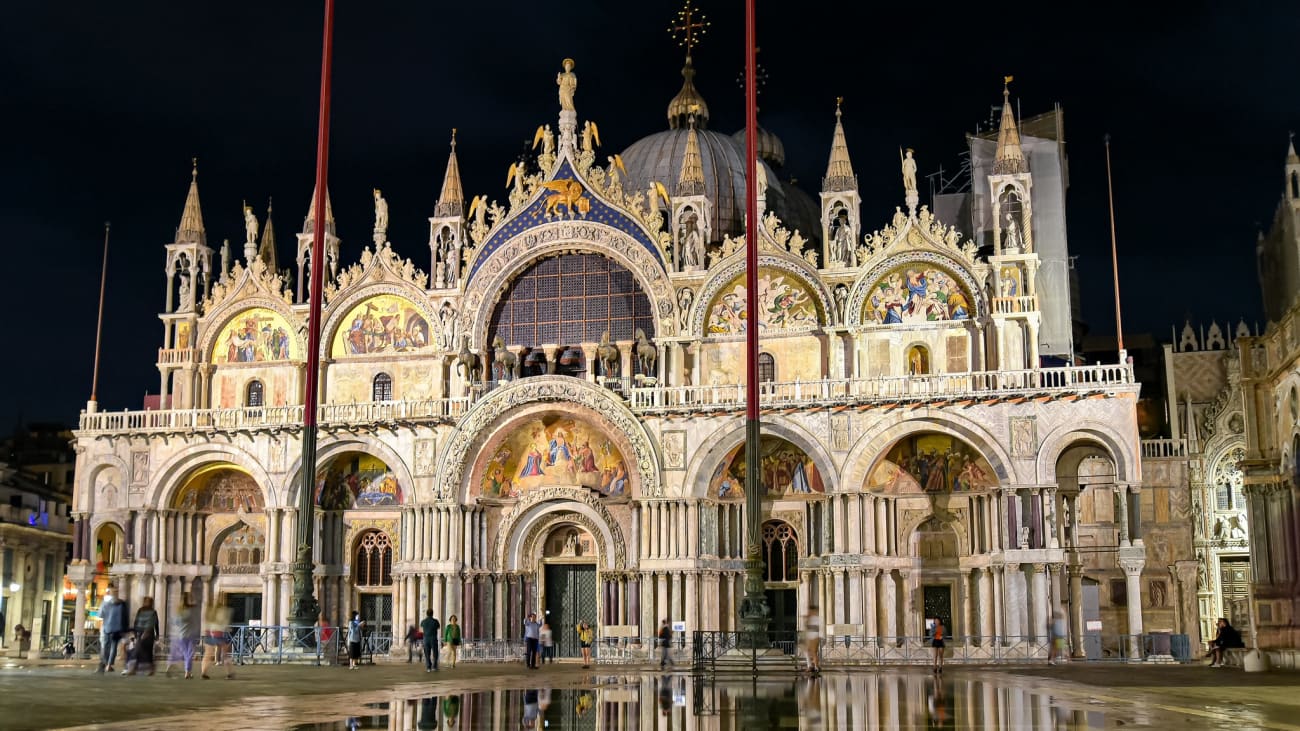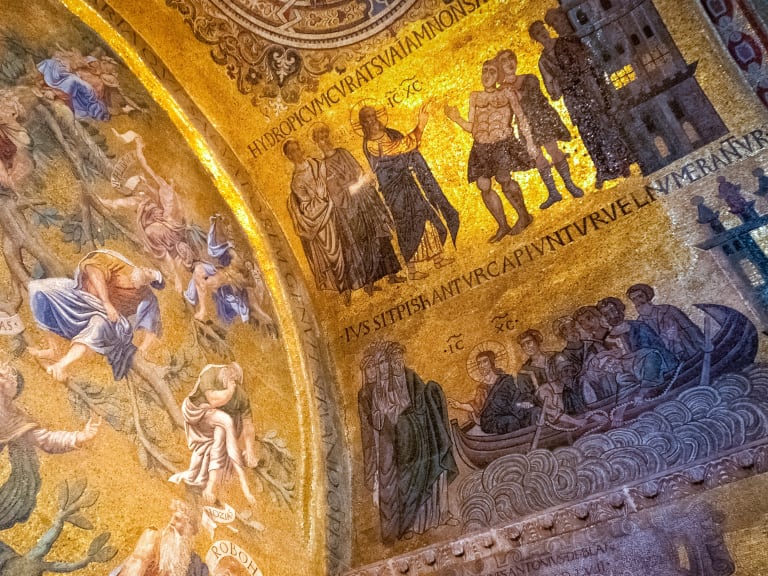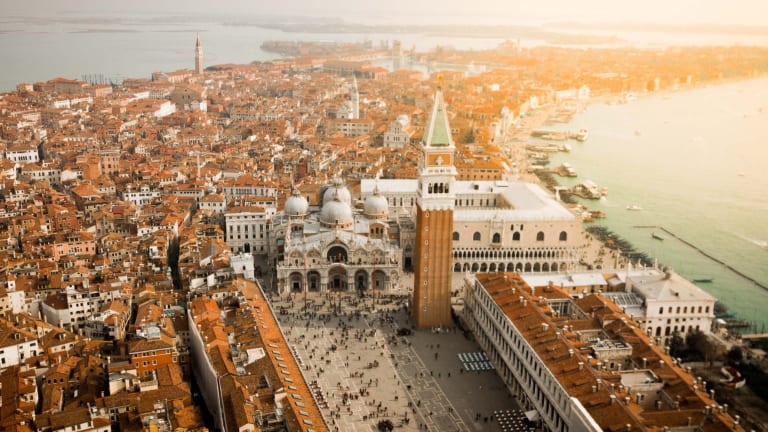Things You Can't Miss at St. Mark’s Basilica in Venice
If your next travel destination is beautiful Venice, a stop to visit St. Mark's Basilica is a must, but what will you find inside St. Mark's? Why is it so famous? Here's everything you need to know.

Patriarchal Cathedral St. Mark's Basilica | ©Jorge Franganillo
When organizing a concise travel itinerary of thingsto see and do in Venice, three activities always come to mind: a visit to see the Doge's Palace, a gondola cruise on the Grand Canal and a tour inside St. Mark's Basilica. This impressive basilica is an important part of the city's religious tradition and history, so I recommend setting aside a few hours to learn all its secrets guided by the following list.
1. Admire the architecture of the facades

The current appearance of St. Mark's Basilica is due to the renovations and reconstructions carried out in the 15th century. Due to its complex and intricate history, this Venetian monument combines in its façade several easily distinguishable architectural styles, predominantly Byzantine Romanesque and Gothic.
The upper part is dominated by large pointed arches of oriental influence, decorated with ceramic tiles characteristic of the Venetian flowery Gothic style. At the top of the arches statues of numerous saints have been placed and the statue of St. Mark himself occupies the place of honor in the central part.
Unlike other great works of its time, the façade of the basilica is wider than it is high, with a predominance of horizontality in its design as a way of balancing the weight and distributing the loads evenly on the sandy ground on which it was built. Although the most famous facade is the one facing St. Mark's Square, the basilica has three named facades: west facade, north facade and south facade.
2. Marvel at the mosaics

As you begin your tour inside St. Mark's you will notice the intricate details that make up its decoration; this can be seen especially in the mosaics that decorate the lunettes or small access vaults.
Pay special attention to the only entirely original mosaic of the Basilica located in the portal of Sant' Alipio, dating back to the thirteenth century and best represents the ancient church of San Marco before adding the overlays of flowery Gothic style that stand out especially on the main facade. The other mosaics of San Marco are actually the result of several restorations carried out between the seventeenth and nineteenth centuries.
3. Pay attention to the floors of St. Mark's Basilica

The beautiful floors of San Marco are another characteristic element you should pay attention to on your tour; composed of geometric patterns and animal designs depicting lions, eagles, griffins, deer, peacocks and other creatures from medieval bestiaries with enormous symbolic power.
The variety of intricate designs are achieved by combining a wide variety of limestones, serpentine and colored marbles; the materials originate from different corners including Greece, Syria, Africa, Istri, Tuscany, Verona and the Alps. The large slabs of the floors of St. Mark's are strategically placed to emphasize the longitudinal axis of the chapel; they are placed under the central dome and the western dome.
4. Impressive with the millions of golden ornaments inside the Basilica

Possibly the most striking feature of the interior of St. Mark's Basilica are the golden mosaics that earned it the name of the golden basilica. The golden mosaics cover almost the entire interior, from the walls to the domes to the vaults. Thanks to their arrangement, they shine in all directions, creating a fantastic interior composition. Amidst the sea of golden pieces you will find representations of biblical episodes, the life of Christ, the Virgin Mary and the apostle St. Mark.
5. The High Altar and the impressive Pala d' Oro

The space dedicated to the High Altar in San Marcos is slightly elevated from the rest of the church; placed between ribbed vaults and four columns covered with sculptures that possibly come from the fall of Constantinople. Under the altar rest the remains of the apostle St. Mark since the eighteenth century but had to be removed due to flooding suffered by the whole of St. Mark's Square and surrounding buildings.
Pala d' Oro: located at the back of the altar, a dazzling painting decorated with precious metals and stones, commissioned in Constantinople in 1102, is considered one of the greatest treasures inside St. Mark's. It depicts religious scenes and saintly figures. It represents religious scenes and figures of saints in miniatures and according to documents of 1769 this masterpiece is composed of: 1300 pearls, 400 pomegranates, 300 sapphires, 90 amethysts, 15 rubies, 4 topaz, as well as metals such as gold and silver.
6. Meet the Treasures of St. Mark's

The St. Mark's treasure is the name given to the collection of liturgical objects used in the celebrations. The collection includes some 283 pieces of gold, silver and various precious materials of high value and of diverse origins. The objects are mostly liturgical chalices, cups and patens; made from Byzantine goldsmithing and adorned with all kinds of hard stones.
The relics of St. Mark are kept in the ancient rooms that link the church to the Ducal Palace and the most significant pieces are usually placed on display at the altar of St. Mark, so pay attention to these details on your visit to the Basilica. Some pieces are on loan to be exhibited in temporary collections in the most important museums in the world.
According to historical records of the 283 pieces that make up the collection, a part is made up of the loot stolen from Constantinople between 1204 and 1261. The collection is divided into four major groups or sections: Ancient and Middle Ages objects, Byzantine art objects, Islamic art objects, and Western art objects.
7. The Museum of St. Mark

The Museum of St. Mark was created at the end of the 19th century, it is located on the internal terraces of the basilica and is the space where the relics of Byzantine sacred art are kept.
The collection includes a series of interesting objects of high historical value such as ancient carpets, liturgical vestments, manuscripts and old mosaic fragments removed during some restorations during the 19th century. It is said that in former times the collection of objects was much larger but due to various events such as fires and thefts, it was diminishing.
8. The sculpture of the Horses of Constantinople

After the participation of Venice in the IV Crusade, several treasures were extracted from Constantinople, the sculpture of the horses, located in the hippodrome of the fallen city, is part of the booty that the Venetians took with them. Made entirely of copper with mercury additions, it represents a quadriga of strong and imposing horses with a spectacular level of detail.
It has not been possible to establish the exact dating of the work, while some are from the Greek period, others are evidently Roman. Experts in antiquities place it between the second century BC and the second century AD. It is known for being the only sculpture of this type rescued from antiquity.
Another interesting fact is that in the 19th century, Emperor Napoleon had the imposing sculpture moved to Paris to create a replica. Currently the chariot of horses that is exhibited on the facade of the Basilica of St. Mark is also a replica of the original, which is properly protected and protected inside the temple.
9. The sculpture I Tetrarchi or monument to the Tetrarchs

Among the treasures extracted by the Venetians during the Crusades in Constantinople you can find several artifacts or treasures of high value placed throughout the basilica. Near Porta della Carta, one of the main attractions of the Doge's Palace, hugging a pillar is I Tetrarchi.
Sculpted in red porphyry, it has a total height of 136 cm.Although the sculpture is linked to the Roman Tetrarchs the truth is that there is no final consensus on the matter, evidence points to the fact that the sculptures may be much older and perhaps were drawn from Mesopotamian and Egyptian civilizations.
The Venetians baptized them as the four thieves and they were placed to guard the outer wall of the Treasury of St. Mark; they function in part as a warning to any malicious person who wants to desecrate the precious goods inside the basilica.
10. Admire the acritane columns

The Acritan columns are the name given to the duo of columns from the ancient and fallen city of Acre. Placed on the south side of the Basilica of St. Mark, they enclose an extremely interesting historical context. Acre was a very ancient city located in what is now Israel. These territories were highly coveted by the Venetian lords, but also by the Genoese. After violent clashes between the two maritime powers, the Venetians were victorious.
After the victory they destroyed the church of San Giovanni d'Acri, removed the two beautifully decorated columns and placed them outside St. Mark's as a warning message to their enemies.
Tips for visiting St. Mark's Basilica

When visiting St. Mark's Basilica you should take into account certain details that will help you save time and effort; to the list of tips to see Venice add the following important points.
If you want to avoid lines
St. Mark's Basilica is among the mainVenetian monuments, being one of the most attractive tourist attractions in the city, there are always queues at the entrance. The only way to easily avoid this inconvenience is to book a guided tour in advance, however the groups available in English may be limited, it is best and advisable to book your tours in advance.
Dress appropriately
On the day of your visit to San Marco, keep in mind that you will be visiting a religious monument, it is important to behave respectfully and adopt the prescribed dress code. The prescribed dress code consists of pants or long skirts with the shoulders covered for both men and women. This applies equally to the other Venetian churches.
Take into account the visiting conditions
St. Mark's Basilica has a capacity limit of 200 people, with an average time inside the Basilica of St. Mark of about 30 minutes. During peak tourist seasons in Venice, the tour period may be shortened by a few minutes.
You should behave in a respectful and silent manner, taking into account the sacredness of the place. Inside the basilica, suitcases and travel bags are not allowed, there is a dedicated luggage storage area in the Ateneo San Basso; access to this area is through an alley to the left of the basilica.
